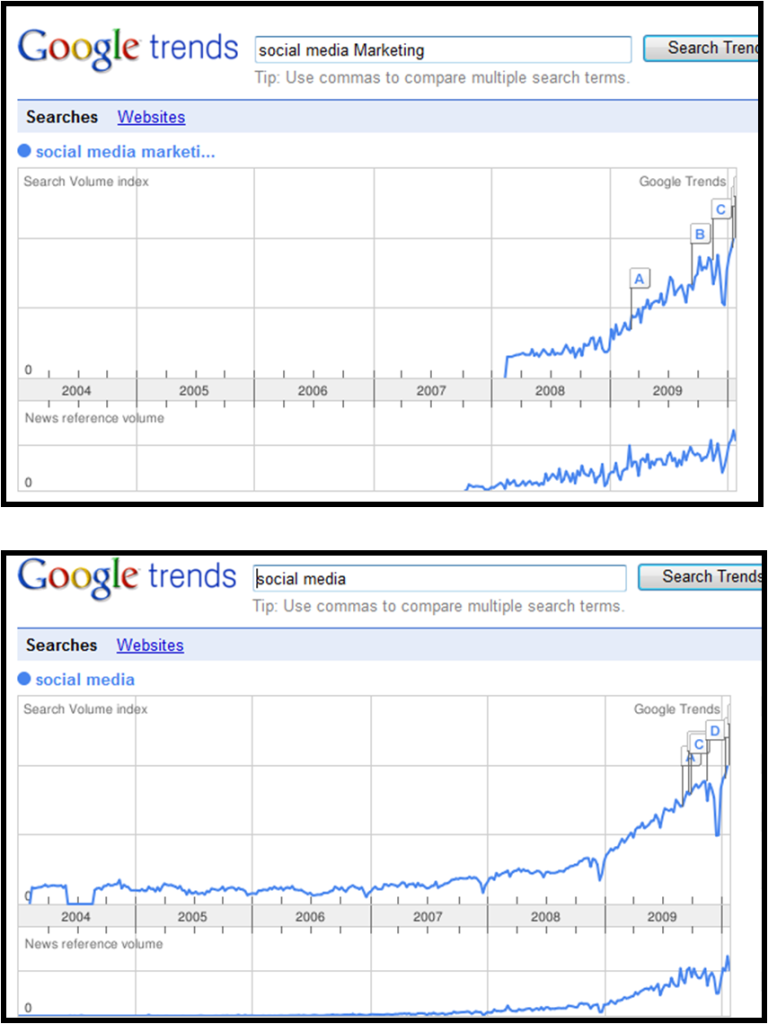No one can deny that the hottest trend and topic in digital marketing, and dare I say marketing as a whole, within the past year has been Social Media. Companies are realizing that they can no longer sit on the sidelines and wait to see what happens, they must get involved and incorporate it into their core marketing infrastructure. This is supported by the fact that in a recently released study by the Society of Digital Marketing Agencies titled the Two Thousand and Ten Digital Marketing Outlook of those surveyed, 45.4% of respondents stated that Social Networks/Applications were their top priority for 2010. No other digital marketing endeavor ranked higher. Furthermore, in a recent report published by Forrester titled US Interactive Marketing Forecast 2009 – 2014 during this time period, investment in Social Media Marketing is expected to have a to have a CAGR (Compounded Annual Growth Rate) of 34%. Here again, no other digital marketing endeavor ranked higher.
So, what’s fueling the strategic need and anticipated investment? Well obviously, it’s a huge channel with a massive audience that’s impossible to avoid. But I will also say that 2009 can also be looked at as the year that Social Media began to really be taken seriously as a marketing tool and channel. Just look at this article from Forbes titled 2010: Marketers Get Serious About Social Media, which further supports this fact. Finally, all one has to do is look at the below graphs from Google Trends. If you look at the term “Social Media Marketing”, it did not even appear on Google’s radar until 2008 and interest skyrocketed in 2009 and if you look at trends associated with search activity for “Social Media” you will see that it puttered along until 2008 and again exploded in 2009.
Therefore, it should come as no surprise that 2010 is the year that Social Media is being defined as a top strategic priority and future investment in the channel is expected to outpace other mediums.
But, what does this really mean to us as marketers? We’ve seen predictions like this in the past, only to find that a few years down the road, what showed great promise did not necessary deliver great results. I certainly remember back around 2001 having to convince people to invest in online strategies, due to the fact that many felt that they had been burned by the internet hype of the 1990’s. While what was developed in the 1990’s provided much of the base foundation for where we are today, one of its shortcomings, was that at the time many felt that the internet did not necessarily live up to its entire promise as a ROI driven marketing vehicle.
So, what can we as marketers do to ensure that we learn from the mistakes of the past so that 2011 and beyond is viewed with as much promise and passion as 2010, when it comes to social media? What can we do to ensure that Social Media is viewed in 2011 and beyond as a strategic necessity, not just something “with potential”. How can we ensure that it continues to evolve as a true digital marketing and communications channel, versus something is considered “cutting edge” and “unique”? (Please note that what I mean here, is that today, many view companies who truly integrate social media into their marketing arsenal are viewed as trail blazers, and while I applaud this, it’s also a sign of how far we have to go, until social media is adopted as a mainstream marketing practice across all business verticals) Finally, how can we ensure that as marketers we don’t look at 2010 and say , much like the many people who spent money on Limp Bizkit CD’s, and say “What were we thinking”?
As we collectively look to approach this new age of Social Media Marketing, the following are a few key things that I feel that we all as marketers can do to ensure the Social Media stays at the forefront, and continues to evolve as a channel and strategic endeavor for 2010 and well into the future:
Measurement
Despite the fact that marketers are planning to invest a lot in social media marketing endeavors, very few are effectively measuring the channel. In a fact, according to his post, only 16% of companies are currently measuring the ROI of their social media programs. This is crazy and indicates a big black hole in the social media puzzle that must be filled. If we don’t sooner or later companies are going to wake-up and say “what’s the business case here”. While we can of course justify building out social media channels based the number of users and market potential, if we don’t start to really focus on measurement and ROI, companies are going to sooner or later start reducing investment. The reason for this is that while there may be a “marketing case”, if you can’t make a “business case”, eventually the enthusiasm from those that actually hold the purse strings and are responsible for budget allocation going to start steering money in other directions.
With this being said, in 2010, it’s imperative that we as marketers place a strong emphasis on measurement and ROI. Now I’ve heard many say that defining ROI for social media is the $10,000,000 question, but in my opinion, it does not have to be. In my opinion this is more of an excuse for people to not focus on measurement and justify why they aren’t really doing it. Therefore, when it comes to measuring social media, the following are a few things to consider:
- What are your key performance metrics for social media success?
- What is your business goal associated with the channel?
- How are your key performance metrics for social media success aligned with your business goals?
- Are you currently tracking, reporting and dashboarding your key performance metrics?
- Are you actively translating “social findings” into “business findings”?
Ultimately, if you take the time to tie all of the above together, you will likely be able to create a solid business case that translates into an ROI driven case for your organization. However, before this can be done, you need to establish a measurement platform. In short, I believe that defining social media ROI is not a one size fits all metric, rather it’s based on the organization and the associated channel. The reason for this is that when it comes down to it, social media is an intensely personal medium that is based on direct human relationships and interaction, therefore, how you measure and define its value is going to be personal as well. Of course there will always be some commonalities across organizations, but if you are waiting for someone to come out and tell you what Social Media ROI means, you may be waiting for a while. However if you focus on building a measurement platform and business case around your particular organization, it will come to you sooner than you might expect.
Engagement
Another key area that we as marketers need to focus on in 2010 is Engagement. Many marketers are currently focused on building a channel in terms of asset deployment and pushing out content, but very few organizations seem to give little thought about how they want communicate and interact with their audience. This is a big mistake, because if you don’t focus on how you are going to engage your audience, the channel will soon stagnate or you will be faced with certain situations such as negative responses and you will not know how to deal with them. Therefore, when developing and planning a social media marketing strategy, it’s imperative that an you build and engagement strategy into it as well, as this will ensure that that foundation you create continues to grow and flourish…not stagnate and ultimately die.
Additionally, when looking to communicate the value associated with social media, engagement can also be looked as a key performance indicator. Therefore, if we as marketers can demonstrate the effectiveness of social media as a means to engage our target market it will help to further convey its value and continued evolution. So how do you do this? While, I could go on and now tell you my thoughts on how to best build an Engagement Strategy, I’m going to instead point you to a recent blog post by colleague Diana Freedman, titled What’s Your Social Media Engagement Strategy?, as it does a terrific job of outlining various things to consider and provides an excellent guide for engagement strategy development.
Integration
It’s important to realize that social media is not an island, but rather something that can be integrated into many other marketing mediums, both offline and online, to create a more robust and interactive campaigns. By doing this you can not only help to grow and evolve your baseline social media infrastructure, but also demonstrate the “extended value” that social media has, beyond the confines of Facebook, YouTube , Twitter, MySpace and others.
One very simple and easy example of social media integration are chiclets. By integrating chiclets into your website, you instantly create a connection between your web based content the extended world of social media. When you think about it, chiclets should be part of any baseline online or web development strategy. The reason I say this is that they help to truly extend life and value of your online presence and enable social advocacy. What I mean here is that we often spend a ton of time and effort driving traffic to our corporate sites and hoping users engage by filling out a form, downloading ad PDF or viewing a particular piece of content. However, on many sites that’s often it, as there is nothing more for users to do. However, if you integrate chiclets into the mix, you suddenly enable users to take your content and share it within the confines of their personal social networks. Everyone always talks about the value of Word of Mouth, well, that’s essentially what a post via a chiclet really is, as someone is taking the time to post something from your site and share it with their friends. This is essentially a Word of Mouth endorsement in the online world, and who does not want more of that. To learn more about chiclets, check out the following white paper titled Chiclets: The Social Glue of the Web, as this will provide you with a solid understanding of they work and can be leveraged for your benefit. However, the bigger idea here is that by integrating social technologies such as chiclets into your online marketing infrastructure, it will make others see the extended value that social media provides.
Another key area associated with integration is your offline marketing efforts. While these can range from very complex and high profile campaigns, as we’ve recently seen with the likes of Best Buy (Twitter) and Honda (Facebook), it can also be as simple as including logos and URL’s in your advertising to let users know where they can find you. For the purposes of this post, I will focus on the later, as I’m huge proponent of letting users know all of the places they can reach and connect with you. Now I have heard some arguments to the contrary that putting social domains in advertising can potentially take traffic away from your corporate site, but the fact is not everyone wants to go to your corporate site to learn about your organization. Some users may feel more comfortable checking out Twitter or Facebook, as that is how they choose to engage on the web. Taking this approach will not only enable you to connect with a larger audience, it will help to also grow your social presence. Integration is also a sign that your company is a more progressive organization that looks to connect with its base on multiple levels. With this being said, the following are just a few places where your social presence can be integrated into your offline presence:
– Print
– Collateral
– Broadcast
– Direct Mail
– Trade Show
– Business Cards
– Recruitment Materials
Therefore, by taking this kind of integrated approach with your offline media it will further help to demonstrate the expanded value of social media as a whole and ensure its continued growth.
Conclusion
I truly feel that as marketers, social media has provided an exciting opportunity to expand and evolve how we connect with and build relationships with audiences. This in turn can really move, grow and evolve our respective businesses. However, in order to us to build the on the current momentum, we need to be sure that we stay one step ahead and continually think about how we can evolve this channel. While I have provided three examples of key areas of focus: Measurement, Engagement and Integration, the list does not stop there.
If 2010, is the year that the marketer “get serious about social media”, then by 2011 marketers better understand what it means “to be serious about social media”. What I mean here is that in 2010 we as marketers need to be sure we are demonstrating the value and importance that social media plays within the organization, not just within the borders of social networks. Ultimately by focusing on measurement/ROI, engagement, integration and more, it will make certain that everyone in your organization from the top on down, comes to understand social media as a strategic business necessity. This in turn will ensure that social media continues to be positioned as a marketing and communications priority for 2011 and beyond.





